More Books by García Márquez

He wrote his masterpiece in 1967, but what works did he write beforehand—and what has he written since? Navigate through this comprehensive list to get ideas for your future reading!
- Leaf Storm and Other Stories
- No One Writes to the Colonel and Other Stories
- In Evil Hour
- One Hundred Years of Solitude
- The Story of a Shipwrecked Sailor
- The Autumn of the Patriarch
- Innocent Eréndira and Other Stories
- Chronicle of a Death Foretold
- Collected Stories
- Clandestine in Chile: The Adventures of Miguel Littin
- Love in the Time of Cholera
- The General in His Labyrinth
- Strange Pilgrims: Twelve Stories
- Of Love and Other Demons
- News of a Kidnapping
- For the Sake of a Country Within Reach of the Children
- Living to Tell the Tale
- Memories of My Melancholy Whores
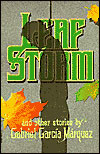
Leaf Storm and Other Stories (1955)
By Gabriel García Márquez
Leaf Storm marks the first appearance of Macondo, García Márquez's famous mythical village. (Macondo means "banana" in Bantu, and it was the name of a banana plantation near his hometown of Aracataca, Colombia.) However, the Macondo of Leaf Storm is a very different Macondo than that of One Hundred Years of Solitude. This Macondo is a devastated place, lonely and broken down, existing in the poverty and solitude left when the banana company pulled up and went away. Drenched by rain, the town emits a palpable odor of decay. The people are closed and bitter, quick to judge and harsh in their sentences. Living among them is the Colonel, a honorable man who takes it on himself to fulfill a promise he made years ago: to bury the Doctor, a salacious and parsimonious foreigner who had the distinction of being the most hated man in Macondo. The story revolves around the relationship between the Doctor and the Colonel's family, and the difficult task of burying the man the rest of the town would rather see rot, forgotten and unattended.
Leaf Storm is a work which clearly shows both the writer's past influences and present state of mind, but also points towards his future development. Faulkner-like, the narrative is told from three different points of view that shift throughout the story: the Colonel, his embittered daughter, and her innocent young son. Each of them sees the same events, but each interpret them differently; and by this technique, we see many sides of Macondo as well.
By Gabriel García Márquez
Leaf Storm marks the first appearance of Macondo, García Márquez's famous mythical village. (Macondo means "banana" in Bantu, and it was the name of a banana plantation near his hometown of Aracataca, Colombia.) However, the Macondo of Leaf Storm is a very different Macondo than that of One Hundred Years of Solitude. This Macondo is a devastated place, lonely and broken down, existing in the poverty and solitude left when the banana company pulled up and went away. Drenched by rain, the town emits a palpable odor of decay. The people are closed and bitter, quick to judge and harsh in their sentences. Living among them is the Colonel, a honorable man who takes it on himself to fulfill a promise he made years ago: to bury the Doctor, a salacious and parsimonious foreigner who had the distinction of being the most hated man in Macondo. The story revolves around the relationship between the Doctor and the Colonel's family, and the difficult task of burying the man the rest of the town would rather see rot, forgotten and unattended.
Leaf Storm is a work which clearly shows both the writer's past influences and present state of mind, but also points towards his future development. Faulkner-like, the narrative is told from three different points of view that shift throughout the story: the Colonel, his embittered daughter, and her innocent young son. Each of them sees the same events, but each interpret them differently; and by this technique, we see many sides of Macondo as well.
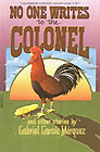
No One Writes to the Colonel and Other Stories (1961)
By Gabriel García Márquez
Having moved out from the shadow of Faulkner—he jokingly claims he did this "by reading Hemingway"—García Márquez creates an absolute jewel of a novella in No One Writes to the Colonel, a story that evokes the entire range of human emotions from misplaced hope to blackest cynicism. The town in which it is located is not Macondo, although Macondo exists downriver; the locale is an unnamed port town where the mail comes in by ship every Friday. Scattered throughout the town are several unforgettable characters: the cynical Doctor; the wry, wealthy, and diabetic Sabas; Father Angel, who forbids the citizens from seeing morally questionable movies by ringing the church bell twelve times; the Colonel's frustrated wife; and most importantly, the Colonel himself. A different Colonel than the central figure in Leaf Storm, he is obviously based on the same archetype—ostensibly García Márquez's grandfather. The Colonel is a stately, honorable man, but perhaps a bit idealistic. For fifteen years every Friday, he has been faithfully anticipating the arrival of the pension check promised by a long overthrown government. Near poverty, half-starved, and living on credit, he and his wife have just lost their son, who was shot to death by the opposing political party. His only legacy is a prize rooster, an excellent fighting cock and a sure-fire winner in next January's match. But to keep this potential breadwinner alive until then, he must be fed—and the more food that goes to the rooster, the less for the Colonel and his wife. The Colonel's predicament unwinds as the narrative takes him through the town and it's cast of characters, all of which have their own unique perspective on the vicissitudes of the world.
By Gabriel García Márquez
Having moved out from the shadow of Faulkner—he jokingly claims he did this "by reading Hemingway"—García Márquez creates an absolute jewel of a novella in No One Writes to the Colonel, a story that evokes the entire range of human emotions from misplaced hope to blackest cynicism. The town in which it is located is not Macondo, although Macondo exists downriver; the locale is an unnamed port town where the mail comes in by ship every Friday. Scattered throughout the town are several unforgettable characters: the cynical Doctor; the wry, wealthy, and diabetic Sabas; Father Angel, who forbids the citizens from seeing morally questionable movies by ringing the church bell twelve times; the Colonel's frustrated wife; and most importantly, the Colonel himself. A different Colonel than the central figure in Leaf Storm, he is obviously based on the same archetype—ostensibly García Márquez's grandfather. The Colonel is a stately, honorable man, but perhaps a bit idealistic. For fifteen years every Friday, he has been faithfully anticipating the arrival of the pension check promised by a long overthrown government. Near poverty, half-starved, and living on credit, he and his wife have just lost their son, who was shot to death by the opposing political party. His only legacy is a prize rooster, an excellent fighting cock and a sure-fire winner in next January's match. But to keep this potential breadwinner alive until then, he must be fed—and the more food that goes to the rooster, the less for the Colonel and his wife. The Colonel's predicament unwinds as the narrative takes him through the town and it's cast of characters, all of which have their own unique perspective on the vicissitudes of the world.
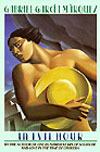
In Evil Hour (1962)
By Gabriel García Márquez
In Evil Hour is stylistically similar to No One Writes to the Colonel. It takes place in the same unnamed town and involves many of the same characters, including Father Angel, the cynical Doctor, and the Mayor. The town has become a lot less friendly since then, however, and tensions run high against a violent and shifting backdrop of politics. Lately, lampoons have been appearing in town—broadsides tacked up overnight, repeating in plain day the gossip about various members of the town. No one knows who is posting these notices about affairs, abortions and crimes but everyone soon becomes involved and as the story progresses the people of the town get increasingly more violent.
Revised a few years before he began One Hundred Years of Solitude the novel shares some of the sense of timeless presence that colors Macondo. Although darker and less whimsical as his masterpiece, it is quite easy to see the seeds from which his later work would grow.
By Gabriel García Márquez
In Evil Hour is stylistically similar to No One Writes to the Colonel. It takes place in the same unnamed town and involves many of the same characters, including Father Angel, the cynical Doctor, and the Mayor. The town has become a lot less friendly since then, however, and tensions run high against a violent and shifting backdrop of politics. Lately, lampoons have been appearing in town—broadsides tacked up overnight, repeating in plain day the gossip about various members of the town. No one knows who is posting these notices about affairs, abortions and crimes but everyone soon becomes involved and as the story progresses the people of the town get increasingly more violent.
Revised a few years before he began One Hundred Years of Solitude the novel shares some of the sense of timeless presence that colors Macondo. Although darker and less whimsical as his masterpiece, it is quite easy to see the seeds from which his later work would grow.

One Hundred Years of Solitude (1967)
By Gabriel García Márquez
One of the 20th century's enduring works, One Hundred Years of Solitude is a widely beloved and acclaimed novel. Alternately reverential and comical, One Hundred Years of Solitude combines the political, personal and spiritual to bring a new consciousness to storytelling.
A rich and brilliant chronicle of life and death, the novel traces the rise and fall of the mythical town of Macondo through the history of the Buendía family. Whether he is describing a passionate affair or the voracity of capitalism, Gabriel García Márquez always writes with the simplicity, ease and purity that are the mark of a master. In the noble, ridiculous, beautiful and tawdry story of the Buendía family, one sees all of humanity, just as in the history, myths, growth and decay of Macondo, one sees all of Latin America. Translated into dozens of languages, this stunning work is no less than an accounting of the history of the human race.
One Hundred Years of Solitude was chosen as an Oprah's Book Club selection in 2004.
By Gabriel García Márquez
One of the 20th century's enduring works, One Hundred Years of Solitude is a widely beloved and acclaimed novel. Alternately reverential and comical, One Hundred Years of Solitude combines the political, personal and spiritual to bring a new consciousness to storytelling.
A rich and brilliant chronicle of life and death, the novel traces the rise and fall of the mythical town of Macondo through the history of the Buendía family. Whether he is describing a passionate affair or the voracity of capitalism, Gabriel García Márquez always writes with the simplicity, ease and purity that are the mark of a master. In the noble, ridiculous, beautiful and tawdry story of the Buendía family, one sees all of humanity, just as in the history, myths, growth and decay of Macondo, one sees all of Latin America. Translated into dozens of languages, this stunning work is no less than an accounting of the history of the human race.
One Hundred Years of Solitude was chosen as an Oprah's Book Club selection in 2004.
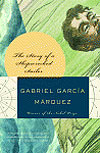
The Story of a Shipwrecked Sailor (1970)
By Gabriel García Márquez
In 1955, García Márquez was working for El Espectador, a newspaper in Bogota, Colombia. when in February of that year, eight crew members of the Caldas, a Colombian destroyer, were washed overboard and disappeared. Ten days later one of them turned up, barely alive, on a deserted beach in northern Colombia. This book, which originally appeared as a series of newspaper articles, is García Márquez 's account of that sailor's ordeal.
By Gabriel García Márquez
In 1955, García Márquez was working for El Espectador, a newspaper in Bogota, Colombia. when in February of that year, eight crew members of the Caldas, a Colombian destroyer, were washed overboard and disappeared. Ten days later one of them turned up, barely alive, on a deserted beach in northern Colombia. This book, which originally appeared as a series of newspaper articles, is García Márquez 's account of that sailor's ordeal.

The Autumn of the Patriarch (1975)
By Gabriel García Márquez
One of Gabriel García Márquez's most intricate and ambitious works, The Autumn of the Patriarch is the tale of a Caribbean tyrant and the corruption of power. Employing an innovative, dreamlike style, the novel is overflowing with symbolic descriptions as it vividly portrays the dying tyrant caught in the prison of his own dictatorship. From charity to deceit, benevolence to violence, fear of God to extreme cruelty, the dictator embodies at once the best and the worst of human nature.
By Gabriel García Márquez
One of Gabriel García Márquez's most intricate and ambitious works, The Autumn of the Patriarch is the tale of a Caribbean tyrant and the corruption of power. Employing an innovative, dreamlike style, the novel is overflowing with symbolic descriptions as it vividly portrays the dying tyrant caught in the prison of his own dictatorship. From charity to deceit, benevolence to violence, fear of God to extreme cruelty, the dictator embodies at once the best and the worst of human nature.

Innocent Eréndira and Other Stories (1979)
By Gabriel García Márquez
A novella published in 1978 as La incréible y triste historia da la cándida Eréndira, some versions of the book also contain two other stories found in the Spanish volume of the same name and nine of the ten early stories found in the Spanish collection Ojos de perro azl. All these stories appear in the Spanish Todos los cuentos and the English Collected Stories.
By Gabriel García Márquez
A novella published in 1978 as La incréible y triste historia da la cándida Eréndira, some versions of the book also contain two other stories found in the Spanish volume of the same name and nine of the ten early stories found in the Spanish collection Ojos de perro azl. All these stories appear in the Spanish Todos los cuentos and the English Collected Stories.

Chronicle of a Death Foretold (1983)
By Gabriel García Márquez
A mysterious and haunting tale of romance and murder that involves the loss of innocence in a small town filled with gossip. The main character, who is well-liked by the community, is accused of taking a woman's virtue who he barely knew. Short and to the point, the book leaves us with a strange sense of inevitability and passions gone terribly awry.
By Gabriel García Márquez
A mysterious and haunting tale of romance and murder that involves the loss of innocence in a small town filled with gossip. The main character, who is well-liked by the community, is accused of taking a woman's virtue who he barely knew. Short and to the point, the book leaves us with a strange sense of inevitability and passions gone terribly awry.
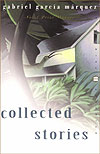
Collected Stories (1984)
By Gabriel García Márquez
Collected here are 26 of Gabriel García Márquez's enchanting short stories, presented in the chronological order of their publication in Spanish from three volumes: Eyes of a Blue Dog, Big Mama's Funeral, and The Incredible and Sad Tale of lnnocent Eréndira and Her Heartless Grandmother. Combining mysticism, history, and humor, the stories in this collection span more than two decades and illuminate the development of García Márquez's prose and his themes of family, poverty, and death that resound throughout his fiction.
By Gabriel García Márquez
Collected here are 26 of Gabriel García Márquez's enchanting short stories, presented in the chronological order of their publication in Spanish from three volumes: Eyes of a Blue Dog, Big Mama's Funeral, and The Incredible and Sad Tale of lnnocent Eréndira and Her Heartless Grandmother. Combining mysticism, history, and humor, the stories in this collection span more than two decades and illuminate the development of García Márquez's prose and his themes of family, poverty, and death that resound throughout his fiction.

Clandestine in Chile The Adventures of Miguel Littin (1986)
By Gabriel García Márquez
In 1973, Chilean film director Miguel Littin was exiled during the turmoil that followed the assassination of President Salvador Allende. Twelve years later, disguised as an Uraguayan businessman, he returned to his country and spent six weeks "making a film that made fun of the dangers of military power.'' In Nobelist (should you just say here: Nobel Prize-winning) Márquez's hands, this is a scary, exhilarating and sometimes hilarious tale of bizarre coincidences, hairbreadth escapes and ludicrous foul-ups (getting a shave and haircut in Concepcion, Littin discovers afterward that his meticulous disguise has been ruined). His brashness is impressive: at one point he manages to shoot some footage inside General(is this correct? - just wouldn't abbreviate if it isn't in the novel) Augusto Pinochet's private office. In the end he escapes by air, fantasizing that the dictator will soon be "dragging behind the 105,000-foot donkey's tail of film we had pinned on him.'' A rousing adventure story, this is also the best reportage available about conditions in Chile.
By Gabriel García Márquez
In 1973, Chilean film director Miguel Littin was exiled during the turmoil that followed the assassination of President Salvador Allende. Twelve years later, disguised as an Uraguayan businessman, he returned to his country and spent six weeks "making a film that made fun of the dangers of military power.'' In Nobelist (should you just say here: Nobel Prize-winning) Márquez's hands, this is a scary, exhilarating and sometimes hilarious tale of bizarre coincidences, hairbreadth escapes and ludicrous foul-ups (getting a shave and haircut in Concepcion, Littin discovers afterward that his meticulous disguise has been ruined). His brashness is impressive: at one point he manages to shoot some footage inside General(is this correct? - just wouldn't abbreviate if it isn't in the novel) Augusto Pinochet's private office. In the end he escapes by air, fantasizing that the dictator will soon be "dragging behind the 105,000-foot donkey's tail of film we had pinned on him.'' A rousing adventure story, this is also the best reportage available about conditions in Chile.

Love in the Time of Cholera (1988)
By Gabriel García Márquez
A masterly evocation of an unrequited passion so strong that it binds three people's lives together for more than 50 years. In the story of Florentino Ariza, who waits more than half a century to declare his undying love to the beautiful Fermina Daza, whom he lost to Dr. Juvenal Urbino so many years before, García Márquez has created a vividly absorbing fictional world, as lush and dazzling as a dream and as real and immediate as our own deepest longings.
Love in the Time of Cholera was chosen as an Oprah's Book Club selection in October 2007. Get the entire reading guide and join the online discussion.
By Gabriel García Márquez
A masterly evocation of an unrequited passion so strong that it binds three people's lives together for more than 50 years. In the story of Florentino Ariza, who waits more than half a century to declare his undying love to the beautiful Fermina Daza, whom he lost to Dr. Juvenal Urbino so many years before, García Márquez has created a vividly absorbing fictional world, as lush and dazzling as a dream and as real and immediate as our own deepest longings.
Love in the Time of Cholera was chosen as an Oprah's Book Club selection in October 2007. Get the entire reading guide and join the online discussion.
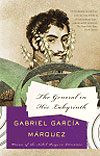
The General in His Labyrinth (1989)
By Gabriel García Márquez
Published in 1989 as El general en su labertino, the subject of this novel is General (added here cuz you refer to him as the General below) Simón Bolívar, whom García Márquez removes from the mythic prison of history and places into the magical alembic of his transforming prose. Bolívar, The Liberator, is seen at the end of his life, near the age of 50, taking a seven-month river voyage from Bogotá to the sea. As the journey progresses from port to port, the humanized Bolívar mirrors this journey in his head, passing from one subject of his life to another—his wars, his defeats, his passions, his sins, his loves—all told against the background and weight of the history that the General helped to create, a labyrinthine and internalized structure of disillusionment and frustration.
Perhaps one of García Márquez's most straightforward and accessible novels, this is truly a very sad work, the product of years of research into the life of Bolívar. García Márquez sees the Liberator as a sympathetic figure who dies seeing his world falling apart—his country, the alliances he forged, his dream of American unity, and even his own body.
By Gabriel García Márquez
Published in 1989 as El general en su labertino, the subject of this novel is General (added here cuz you refer to him as the General below) Simón Bolívar, whom García Márquez removes from the mythic prison of history and places into the magical alembic of his transforming prose. Bolívar, The Liberator, is seen at the end of his life, near the age of 50, taking a seven-month river voyage from Bogotá to the sea. As the journey progresses from port to port, the humanized Bolívar mirrors this journey in his head, passing from one subject of his life to another—his wars, his defeats, his passions, his sins, his loves—all told against the background and weight of the history that the General helped to create, a labyrinthine and internalized structure of disillusionment and frustration.
Perhaps one of García Márquez's most straightforward and accessible novels, this is truly a very sad work, the product of years of research into the life of Bolívar. García Márquez sees the Liberator as a sympathetic figure who dies seeing his world falling apart—his country, the alliances he forged, his dream of American unity, and even his own body.
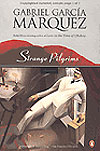
Strange Pilgrims Twelve 12 Stories (1992)
By Gabriel García Márquez
These 12 extraordinary stories by South America's preeminent man of letters are set in contemporary Europe and recount the peculiar and amazing experiences that befall Latin Americans visiting or living abroad.
In these stories, the reader meets a cast of characters: An ailing Caribbean ex-President is befriended by an ambitious ambulance driver and his headstrong wife. Margarito Duarte comes to Rome from the Colombian Andes with a box the shape and size of a cello case in order to show the Pope its contents. A woman who wears a snake ring with emerald eyes and is known only as Frau Frieda to the Latin American students in Vienna makes a living by telling her dreams to wealthy families. A pretty Mexican music hall performer is returning to Barcelona when her car breaks down, and she ends up in an insane asylum. In Tuscany, a vacationing family visits a Renaissance castle now owned by a famous Venezuelan writer and meets up with a phantom. Maria dos Prazeres, once Barcelona's most sought-after lady of the night, has a dream in which death appears so she begins to plan her own funeral. A widow dressed in the habit of Saint Francis sails to Rome from Argentina to meet the Pope. A beautiful Caribbean boy is driven mad in Spain. A German governess destroys the summer for her wards—and is herself destroyed. Billy Sanchez takes his pregnant wife with a cut on her ring finger to a hospital in Paris—and never sees her again. In this breathtaking collection, Gabriel García Márquez invites us into worlds of majesty and magic, from which we emerge spellbound.
By Gabriel García Márquez
These 12 extraordinary stories by South America's preeminent man of letters are set in contemporary Europe and recount the peculiar and amazing experiences that befall Latin Americans visiting or living abroad.
In these stories, the reader meets a cast of characters: An ailing Caribbean ex-President is befriended by an ambitious ambulance driver and his headstrong wife. Margarito Duarte comes to Rome from the Colombian Andes with a box the shape and size of a cello case in order to show the Pope its contents. A woman who wears a snake ring with emerald eyes and is known only as Frau Frieda to the Latin American students in Vienna makes a living by telling her dreams to wealthy families. A pretty Mexican music hall performer is returning to Barcelona when her car breaks down, and she ends up in an insane asylum. In Tuscany, a vacationing family visits a Renaissance castle now owned by a famous Venezuelan writer and meets up with a phantom. Maria dos Prazeres, once Barcelona's most sought-after lady of the night, has a dream in which death appears so she begins to plan her own funeral. A widow dressed in the habit of Saint Francis sails to Rome from Argentina to meet the Pope. A beautiful Caribbean boy is driven mad in Spain. A German governess destroys the summer for her wards—and is herself destroyed. Billy Sanchez takes his pregnant wife with a cut on her ring finger to a hospital in Paris—and never sees her again. In this breathtaking collection, Gabriel García Márquez invites us into worlds of majesty and magic, from which we emerge spellbound.
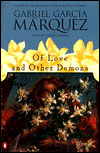
Of Love and Other Demons (1995)
By Gabriel García Márquez
Of Love and Other Demons is set in a South American seaport in the colonial era, a time of viceroys and bishops, enlightened men and Inquisitors, saints and lepers and pirates. Sierva Maria, only child of a decaying noble family, has been raised in the slaves' courtyard of her father's cobwebbed mansion while her mother succumbs to fermented honey and cacao on a faraway plantation. On her 12th birthday, the girl is bitten by a rabid dog—and even as the wound is healing she is made to endure therapies indistinguishable from tortures. Believed, finally, to be possessed, she is brought to a convent for observation. And into her cell stumbles Father Cayetano Delaura, the Bishop's protégé, who has already dreamed about a girl with hair trailing after her like a bridal train. As he tends to her with holy water and sacramental oils, breathing gently on her chafed skin to cool it, feeding her smuggled pastries, Delaura feels "something immense and irreparable" happening to him. It is love, "the most terrible demon of all."
Unsettling and indelible, Of Love and Other Demons haunts us with its evocation of an exotic world while it treats, majestically, of the most universal experiences known to woman and man.
By Gabriel García Márquez
Of Love and Other Demons is set in a South American seaport in the colonial era, a time of viceroys and bishops, enlightened men and Inquisitors, saints and lepers and pirates. Sierva Maria, only child of a decaying noble family, has been raised in the slaves' courtyard of her father's cobwebbed mansion while her mother succumbs to fermented honey and cacao on a faraway plantation. On her 12th birthday, the girl is bitten by a rabid dog—and even as the wound is healing she is made to endure therapies indistinguishable from tortures. Believed, finally, to be possessed, she is brought to a convent for observation. And into her cell stumbles Father Cayetano Delaura, the Bishop's protégé, who has already dreamed about a girl with hair trailing after her like a bridal train. As he tends to her with holy water and sacramental oils, breathing gently on her chafed skin to cool it, feeding her smuggled pastries, Delaura feels "something immense and irreparable" happening to him. It is love, "the most terrible demon of all."
Unsettling and indelible, Of Love and Other Demons haunts us with its evocation of an exotic world while it treats, majestically, of the most universal experiences known to woman and man.
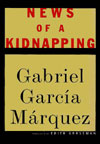
News of a Kidnapping (1996)
By Gabriel García Márquez
This astonishing story chronicles the 1990 kidnappings of 10 Colombian men and women—all journalists but one—by the Medellin drug boss Pablo Escobar. The carefully orchestrated abductions were Escobar's attempt to extort from the government its assurance that he, and other narcotics traffickers, would not be extradited to the United States if they were to surrender.
By Gabriel García Márquez
This astonishing story chronicles the 1990 kidnappings of 10 Colombian men and women—all journalists but one—by the Medellin drug boss Pablo Escobar. The carefully orchestrated abductions were Escobar's attempt to extort from the government its assurance that he, and other narcotics traffickers, would not be extradited to the United States if they were to surrender.

For the Sake of a Country Within Reach of the Children (1998)
By Gabriel García Márquez
This beautiful essay by the Colombian Nobel Prize-winning author is one of his most lucid and stunning literary expressions. Originally written as a prologue to a "state of the nation" analysis recently published by a group of eminent Colombian thinkers, it drafts a virtual navigation chart for the future of Colombia, affirming the country's vast human potential and emphasizing the powers of education and national spirit. Four-color photographs enliven this work.
By Gabriel García Márquez
This beautiful essay by the Colombian Nobel Prize-winning author is one of his most lucid and stunning literary expressions. Originally written as a prologue to a "state of the nation" analysis recently published by a group of eminent Colombian thinkers, it drafts a virtual navigation chart for the future of Colombia, affirming the country's vast human potential and emphasizing the powers of education and national spirit. Four-color photographs enliven this work.
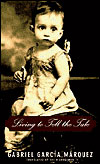
Living to Tell the Tale (2003)
By Gabriel García Márquez
In this long-awaited first volume of a planned trilogy, (can we say the most acclaimed?) the most acclaimed and revered living Nobel laureate begins to tell us the story of his life.
Like all his work, Living to Tell the Tale is a magnificent piece of writing. It spans Gabriel García Márquez's life from his birth in 1927 through the start of his career as a writer to the moment in the 1950s when he proposed to the woman who would become his wife. It has the shape, the quality, and the vividness of a conversation with the reader—a tale of people, places, and events as they occur to him: the colorful stories of his eccentric family members; the great influence of his mother and maternal grandfather; his consuming career in journalism, and the friends and mentors who encouraged him; the myths and mysteries of his beloved Colombia; personal details, undisclosed until now, that would appear later, transmuted and transposed, in his fiction; and, above all, his fervent desire to become a writer. And, as in his fiction, the narrator here is an inspired observer of the physical world, able to make clear the emotions and passions that lie at the heart of a life—in this instance, his own.
Living to Tell the Tale is a radiant, powerful, and beguiling memoir that gives us the formation of Gabriel García Márquez as a writer and as a man.
Learn more about Gabo's bestselling autobiography from the publisher!
By Gabriel García Márquez
In this long-awaited first volume of a planned trilogy, (can we say the most acclaimed?) the most acclaimed and revered living Nobel laureate begins to tell us the story of his life.
Like all his work, Living to Tell the Tale is a magnificent piece of writing. It spans Gabriel García Márquez's life from his birth in 1927 through the start of his career as a writer to the moment in the 1950s when he proposed to the woman who would become his wife. It has the shape, the quality, and the vividness of a conversation with the reader—a tale of people, places, and events as they occur to him: the colorful stories of his eccentric family members; the great influence of his mother and maternal grandfather; his consuming career in journalism, and the friends and mentors who encouraged him; the myths and mysteries of his beloved Colombia; personal details, undisclosed until now, that would appear later, transmuted and transposed, in his fiction; and, above all, his fervent desire to become a writer. And, as in his fiction, the narrator here is an inspired observer of the physical world, able to make clear the emotions and passions that lie at the heart of a life—in this instance, his own.
Living to Tell the Tale is a radiant, powerful, and beguiling memoir that gives us the formation of Gabriel García Márquez as a writer and as a man.
Learn more about Gabo's bestselling autobiography from the publisher!

Memories of My Melancholy Whores (2005)
By Gabriel García Márquez
On the eve of his 90th birthday, a bachelor decides to give himself a wild night of love with a virgin. As is his habit—he has purchased hundreds of women—he asks a madam for her assistance. The 14-year-old girl who is procured for him is enchanting, but exhausted as she is from caring for siblings and her job sewing buttons, she can do little but sleep. Yet with this sleeping beauty at his side, it is he who awakens to a romance he has never known.
Tender, knowing and slyly comic, Memories of My Melancholy Whores is an exquisite addition to the master's work.
By Gabriel García Márquez
On the eve of his 90th birthday, a bachelor decides to give himself a wild night of love with a virgin. As is his habit—he has purchased hundreds of women—he asks a madam for her assistance. The 14-year-old girl who is procured for him is enchanting, but exhausted as she is from caring for siblings and her job sewing buttons, she can do little but sleep. Yet with this sleeping beauty at his side, it is he who awakens to a romance he has never known.
Tender, knowing and slyly comic, Memories of My Melancholy Whores is an exquisite addition to the master's work.



